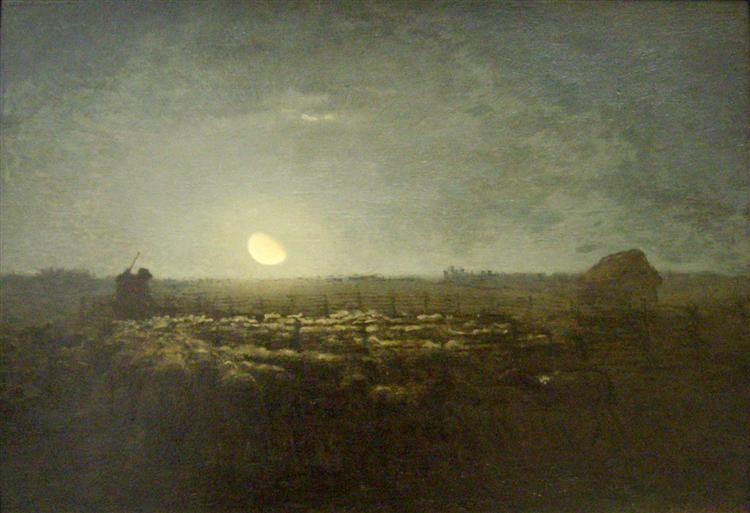Beschreibung
The work "The Sheepfold - Moonlight" (1873) by Jean-François Millet is a poetic manifestation of the connection between man, nature and the cycle of rural life, fundamental characteristics of the realist movement in which Millet stood out. Through his ability to capture the essence of everyday life, especially in the countryside, the artist reflects in this painting a scene that, although simple in appearance, is imbued with deep meaning and an atmospheric sensitivity that invites contemplation.
The composition of the painting is structured around the subtle interplay between the moonlight and the surroundings it illuminates. The sheep, which are grouped together in a pen, become the protagonists of the painting, symbolising not only pastoral life but also the innocence and fragility of existence. The colour palette used by Millet is predominantly dark, in shades of blue and black, which lend a sense of depth and mystery to the night scene. The soft moonlight creates a contrast that highlights the shape and texture of the sheep’s fur, as well as the details of the pen, giving the composition a life of its own. This use of contrast between light and shadow is not accidental, but becomes a vehicle through which Millet explores themes of safety and vulnerability in nature.
Although there are no human figures present in this composition, the absence of characters only emphasises the intimate connection between man and his environment. The sheep can be interpreted as a symbol of the peasants who, although invisible in this setting, are central to rural life and the natural loop of the world that this work depicts. Millet, known for his humanistic approach to peasant life, uses this image to hint at the labour and dedication of those who work the land, suggesting that although they are not seen, their efforts are the vital thread that sustains the harmony depicted here.
Millet is a master of gradual tonal development and atmosphere in his paintings. In The Sheepfold - Moonlight, the soft lunar lighting not only defines the form, but also evokes a sense of calm and serenity. This soothing atmosphere invites us into a moment of reflection, as if we were participating in a pause in time that allows us to observe the rural world in its purest state. The treatment of light is reminiscent of other masters such as Rembrandt, but Millet employs this style in a way that makes it unique, showing his deep appreciation for rural life.
Millet's work, particularly in the context of the 19th century, is significant for its ability to capture the essence of everyday life, breaking away from calls for glorification or idealization. In "The Sheepfold - Moonlight," Millet makes us perceive the beauty inherent in simplicity, while inviting us to reflect on man's place within the vast tapestry of nature. This painting is a testament to Millet's talent for depicting modern peasant life in a sensitive and honest manner, a legacy that has survived in art history and continues to resonate today.
Thus, "El Penil De Ovejas - Luz De Luna" reminds us that behind every lamb and every shadow there are stories of life, effort and dedication, immortalized for contemplation in the beauty of art. The work not only captures a moment, but evokes a broader sense of belonging and continuity in the cycle of life, a visual narrative that continues to speak to generations of viewers.
KUADROS ©, a famous painting on your wall.
Hand-made oil painting reproductions, with the quality of professional artists and the distinctive seal of KUADROS ©.
Painting reproduction service with satisfaction guarantee. If you are not completely satisfied with the replica of your painting, we will refund 100% of your money.

